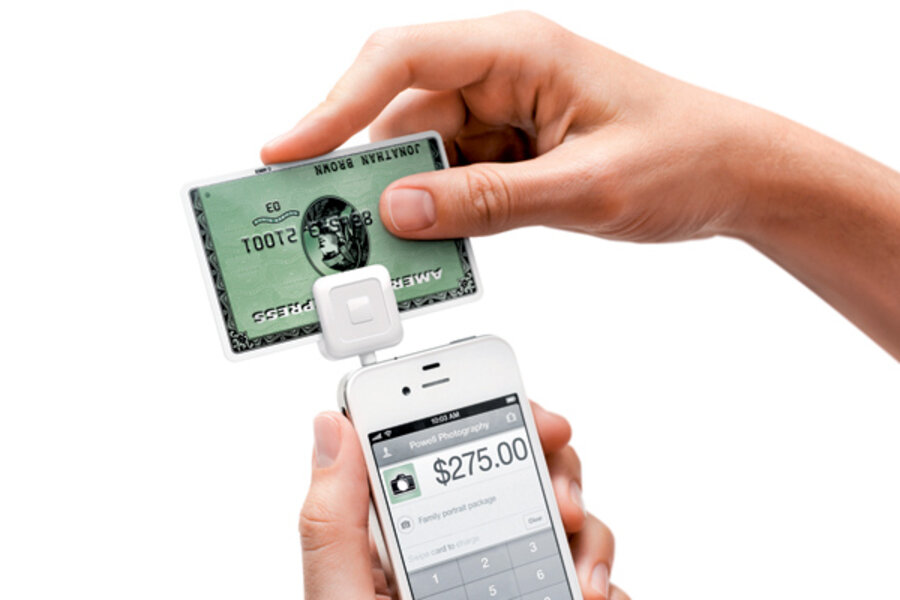Cookie sales soar as Girl Scouts adopt smart phones, credit cards
Loading...
Few things can derail a Girl Scout cookie sale quite like the words, "I don't have any cash."
Whether hawking Thin Mints outside the local supermarket or selling the brand-new Savannah Smiles at a booth in the mall, Girl Scouts have watched countless potential buyers walk away because the troops could only accept cash or check.
These days, shoppers increasingly rely on credit or debit cards, says John Graves, chief financial officer for the Girl Scouts of North East Ohio, which oversees 3,500 troops and 40,000 girls. So Mr. Graves turned to Sage Mobile Payments, one of several companies that turn smart phones into card readers.
"Now, when people say that they don't have any cash on them, the girls say with big smiles, 'We take Master Card and Visa,' " he says. "Everyone is pleasantly surprised that Girl Scouts have this technology. It's easier and more convenient. People are just more enthusiastic about the sale."
That enthusiasm has led to increased sales, not just for the Girl Scouts but also for small businesses nationwide. Mobile-payment companies such as Sage, Square, and Intuit processed billions of dollars in smart-phone credit transactions last year. Square alone is on track to handle $4 billion a year, twice what it expected in October.
Sage and Square both work through plastic dongles that plug into the headphone jack of iPhones, iPads, and many Android smart phones. Customers swipe their cards through the small device, then sign their name on the phone's touch screen. Receipts arrive via e-mail.
Smart phones send the transaction to Square, Sage, or one of the other mobile-payment firms, which passes it along to the credit-card company, keeps 1 to 3 percent of the sale for itself, and deposits the remainder of the money into the seller's bank account. Debit cards work, too. The phones do not retain any card numbers and, according to the companies, come with multiple layers of security and encryption to minimize fraud.
Before these phone-based options existed, Girl Scouts experimented with dedicated card readers. The results were not inspiring.
"They were very slow, and it became a hassle to carry them around from one place to another," says Amanda Hamaker, manager of product sales for Girl Scouts of the USA. "The trend we saw is that people would try them for about a year and then say it's not worth it."
Now, the trend has flipped. About 35 of the 120 Girl Scout regional offices have adopted smart-phone payments, double the number from a year ago. Given the enthusiastic feedback and healthy bump in sales, Ms. Hamaker expects more to sign on next year.
A pilot program of 150 troops in northeast Ohio saw cookie purchases jump by 13 percent last year, while the Scouts without card readers saw no real improvement. This year, Graves handed out Sage readers to 536 troops; they had their largest restocking order in history.
Smart-phone payments arrive just as the United States is dramatically changing its spending methods. Americans wrote half as many checks last year compared with 2004, according to the Federal Reserve. Meanwhile, credit- and debit-card purchases, collectively, nearly doubled.
As people lean more on plastic, the research firm Aite Group in Boston expects cash payments to fall by 16 percent between 2010 and 2015.
These shifts have already affected small businesses, restaurants, and artisans, such as Square's cofounder Jim McKelvey. The company's creation myth revolves around a $3,000 glass faucet that Mr. McKelvey had trouble selling. Potential customers all wanted to pay with credit cards. So the serial tech entrepreneur (and glass blower) teamed up with Twitter creator Jack Dorsey to harness the supercomputer that now lives in people's pockets.
Smart phones already offer the processor, operating system, and Internet connection necessary for a credit or debit transaction. They only needed to craft an inexpensive magnetic-strip reader and the software to handle the purchase.
Best Buy, Radio Shack, and other retailers sell the peripherals for between $10 and $99, but Square now hands out the devices free of charge to anyone who signs up through its website. Graves said that Girl Scout troops received free readers from Sage, as well.
"Now I get calls from parents," says Graves. "Their phone contracts are almost up and they want to know, 'What phone should I buy? What will work with these readers?' "
For more on how technology intersect daily life, follow Chris on Twitter @venturenaut.







